Economy Literacy Report: Globalization, Markets, and Finance
VerifiedAdded on 2019/12/18
|12
|3383
|194
Report
AI Summary
This report provides a comprehensive analysis of economic literacy, exploring the impact of globalization on consumers and firms, and examining the movement and shifting of demand curves. It delves into market structures, including imperfect competition and barriers to entry for monopolies, while also evaluating environmental policies used to address market failures. The report further investigates the circular flow of income and macroeconomic concepts like unemployment. Additionally, it includes an analysis of financial statements, ratio analysis, and the phases of management accounting, along with a discussion of relevant and irrelevant costs, risk, return and the concept of capital structure.
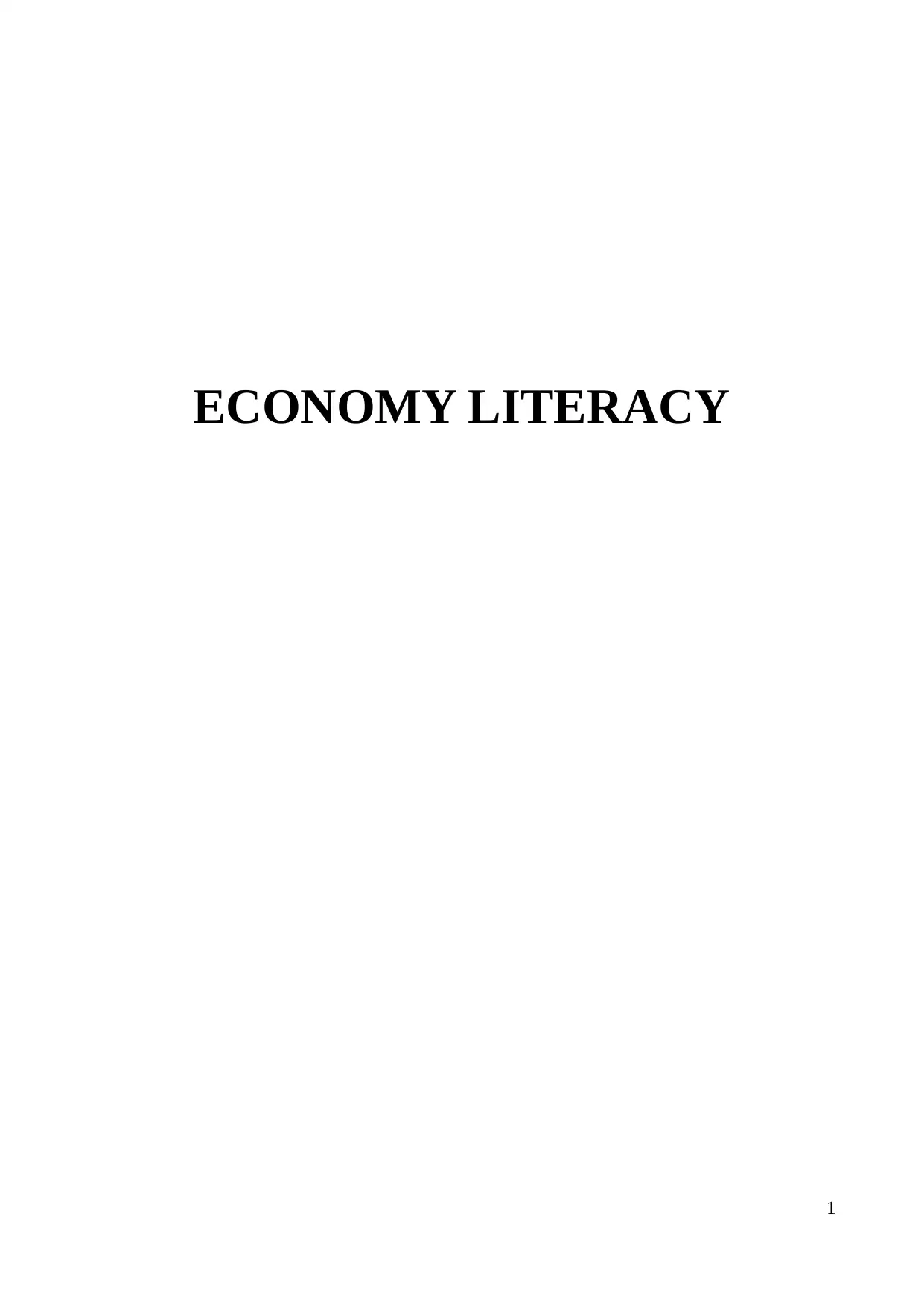
ECONOMY LITERACY
1
1
Paraphrase This Document
Need a fresh take? Get an instant paraphrase of this document with our AI Paraphraser
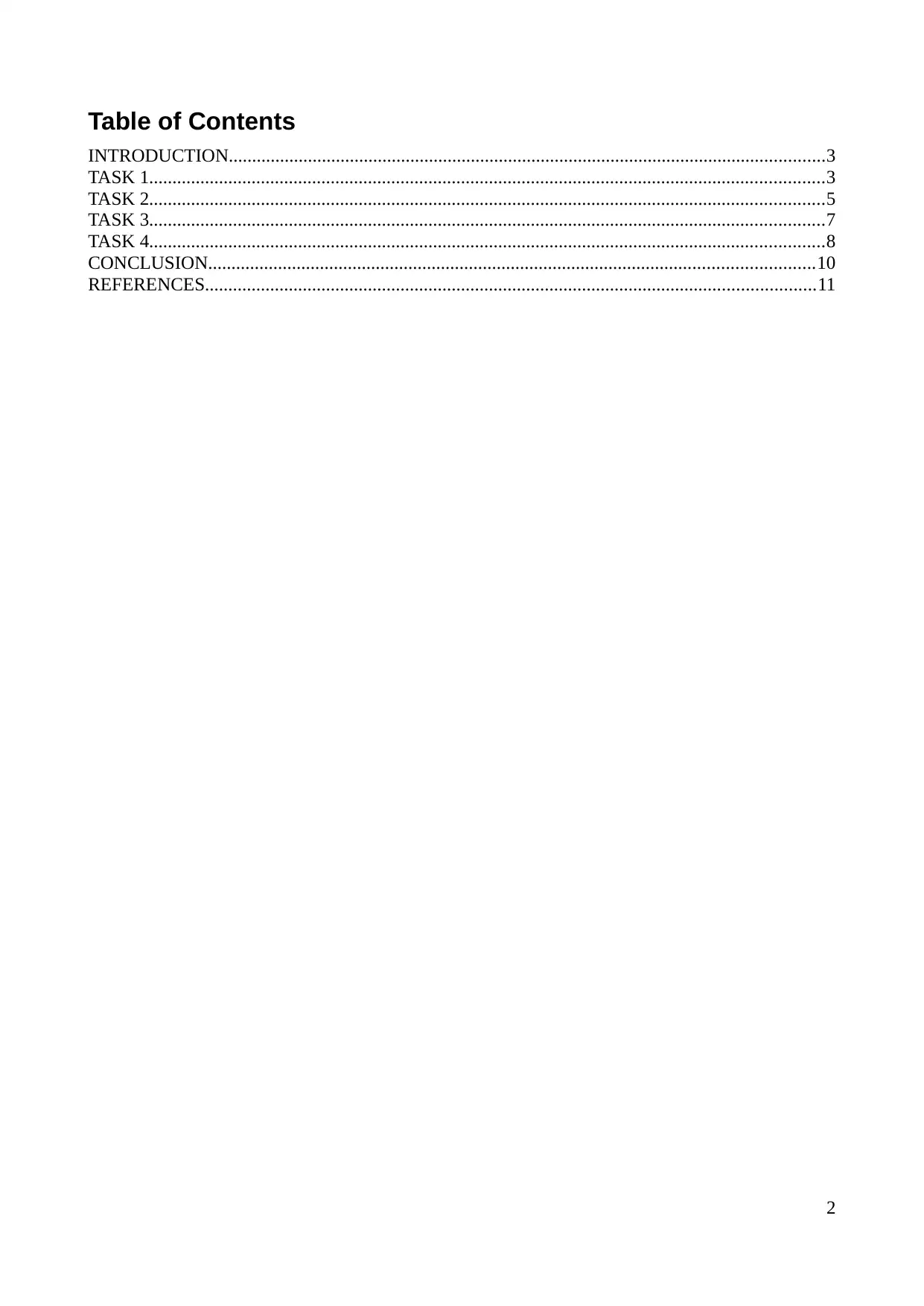
Table of Contents
INTRODUCTION................................................................................................................................3
TASK 1.................................................................................................................................................3
TASK 2.................................................................................................................................................5
TASK 3.................................................................................................................................................7
TASK 4.................................................................................................................................................8
CONCLUSION..................................................................................................................................10
REFERENCES...................................................................................................................................11
2
INTRODUCTION................................................................................................................................3
TASK 1.................................................................................................................................................3
TASK 2.................................................................................................................................................5
TASK 3.................................................................................................................................................7
TASK 4.................................................................................................................................................8
CONCLUSION..................................................................................................................................10
REFERENCES...................................................................................................................................11
2
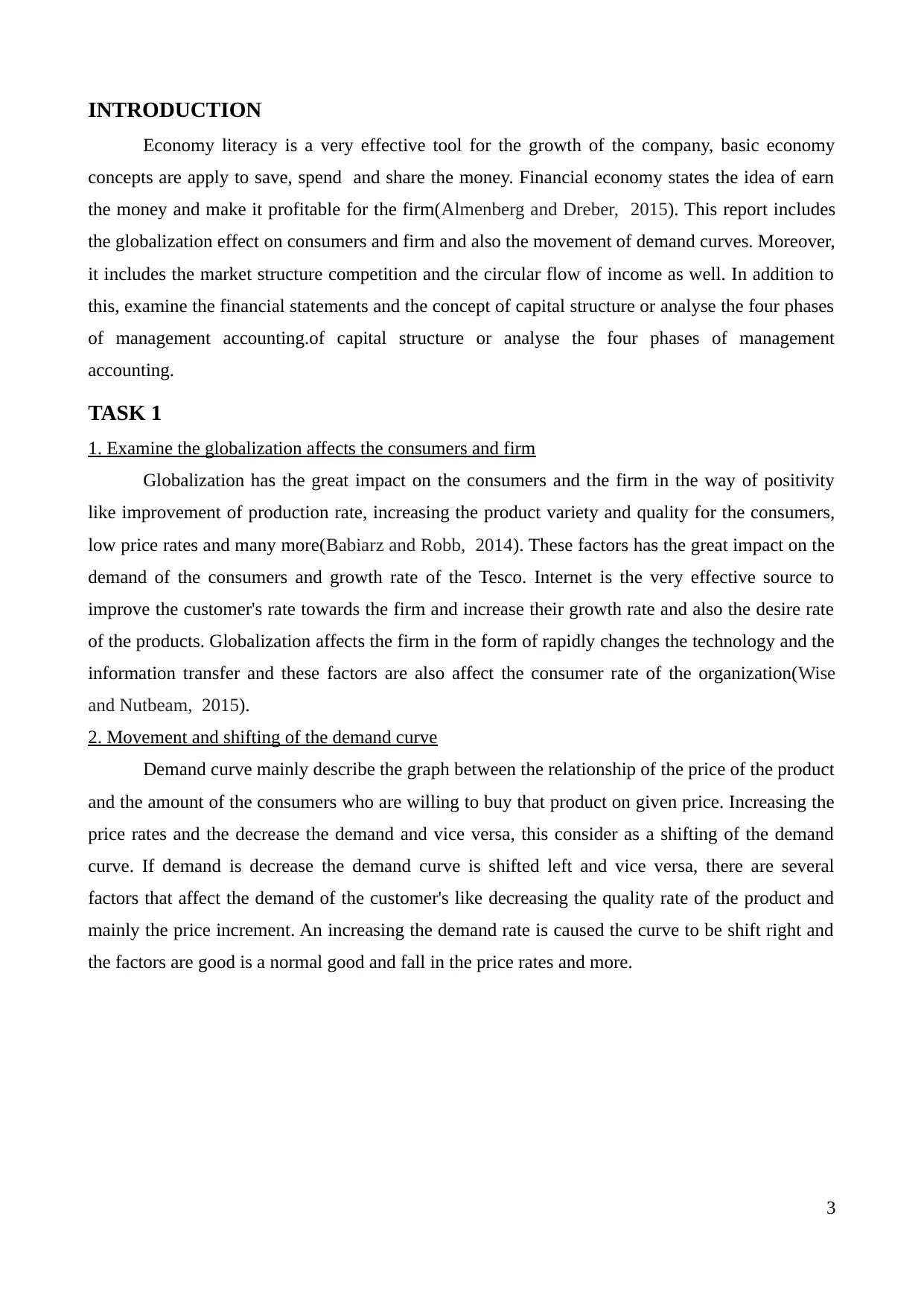
INTRODUCTION
Economy literacy is a very effective tool for the growth of the company, basic economy
concepts are apply to save, spend and share the money. Financial economy states the idea of earn
the money and make it profitable for the firm(Almenberg and Dreber, 2015). This report includes
the globalization effect on consumers and firm and also the movement of demand curves. Moreover,
it includes the market structure competition and the circular flow of income as well. In addition to
this, examine the financial statements and the concept of capital structure or analyse the four phases
of management accounting.of capital structure or analyse the four phases of management
accounting.
TASK 1
1. Examine the globalization affects the consumers and firm
Globalization has the great impact on the consumers and the firm in the way of positivity
like improvement of production rate, increasing the product variety and quality for the consumers,
low price rates and many more(Babiarz and Robb, 2014). These factors has the great impact on the
demand of the consumers and growth rate of the Tesco. Internet is the very effective source to
improve the customer's rate towards the firm and increase their growth rate and also the desire rate
of the products. Globalization affects the firm in the form of rapidly changes the technology and the
information transfer and these factors are also affect the consumer rate of the organization(Wise
and Nutbeam, 2015).
2. Movement and shifting of the demand curve
Demand curve mainly describe the graph between the relationship of the price of the product
and the amount of the consumers who are willing to buy that product on given price. Increasing the
price rates and the decrease the demand and vice versa, this consider as a shifting of the demand
curve. If demand is decrease the demand curve is shifted left and vice versa, there are several
factors that affect the demand of the customer's like decreasing the quality rate of the product and
mainly the price increment. An increasing the demand rate is caused the curve to be shift right and
the factors are good is a normal good and fall in the price rates and more.
3
Economy literacy is a very effective tool for the growth of the company, basic economy
concepts are apply to save, spend and share the money. Financial economy states the idea of earn
the money and make it profitable for the firm(Almenberg and Dreber, 2015). This report includes
the globalization effect on consumers and firm and also the movement of demand curves. Moreover,
it includes the market structure competition and the circular flow of income as well. In addition to
this, examine the financial statements and the concept of capital structure or analyse the four phases
of management accounting.of capital structure or analyse the four phases of management
accounting.
TASK 1
1. Examine the globalization affects the consumers and firm
Globalization has the great impact on the consumers and the firm in the way of positivity
like improvement of production rate, increasing the product variety and quality for the consumers,
low price rates and many more(Babiarz and Robb, 2014). These factors has the great impact on the
demand of the consumers and growth rate of the Tesco. Internet is the very effective source to
improve the customer's rate towards the firm and increase their growth rate and also the desire rate
of the products. Globalization affects the firm in the form of rapidly changes the technology and the
information transfer and these factors are also affect the consumer rate of the organization(Wise
and Nutbeam, 2015).
2. Movement and shifting of the demand curve
Demand curve mainly describe the graph between the relationship of the price of the product
and the amount of the consumers who are willing to buy that product on given price. Increasing the
price rates and the decrease the demand and vice versa, this consider as a shifting of the demand
curve. If demand is decrease the demand curve is shifted left and vice versa, there are several
factors that affect the demand of the customer's like decreasing the quality rate of the product and
mainly the price increment. An increasing the demand rate is caused the curve to be shift right and
the factors are good is a normal good and fall in the price rates and more.
3
⊘ This is a preview!⊘
Do you want full access?
Subscribe today to unlock all pages.

Trusted by 1+ million students worldwide
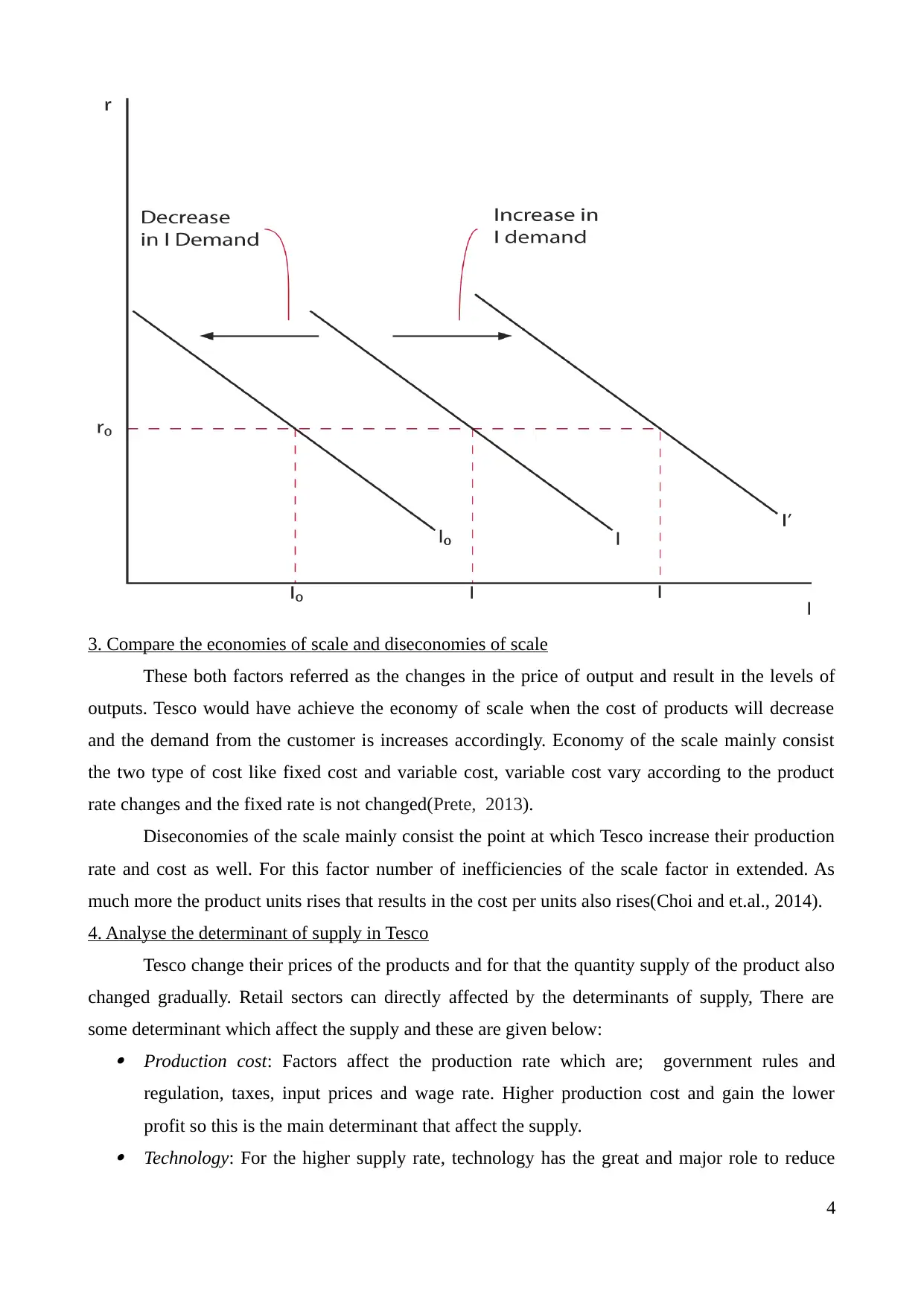
3. Compare the economies of scale and diseconomies of scale
These both factors referred as the changes in the price of output and result in the levels of
outputs. Tesco would have achieve the economy of scale when the cost of products will decrease
and the demand from the customer is increases accordingly. Economy of the scale mainly consist
the two type of cost like fixed cost and variable cost, variable cost vary according to the product
rate changes and the fixed rate is not changed(Prete, 2013).
Diseconomies of the scale mainly consist the point at which Tesco increase their production
rate and cost as well. For this factor number of inefficiencies of the scale factor in extended. As
much more the product units rises that results in the cost per units also rises(Choi and et.al., 2014).
4. Analyse the determinant of supply in Tesco
Tesco change their prices of the products and for that the quantity supply of the product also
changed gradually. Retail sectors can directly affected by the determinants of supply, There are
some determinant which affect the supply and these are given below: Production cost: Factors affect the production rate which are; government rules and
regulation, taxes, input prices and wage rate. Higher production cost and gain the lower
profit so this is the main determinant that affect the supply. Technology: For the higher supply rate, technology has the great and major role to reduce
4
These both factors referred as the changes in the price of output and result in the levels of
outputs. Tesco would have achieve the economy of scale when the cost of products will decrease
and the demand from the customer is increases accordingly. Economy of the scale mainly consist
the two type of cost like fixed cost and variable cost, variable cost vary according to the product
rate changes and the fixed rate is not changed(Prete, 2013).
Diseconomies of the scale mainly consist the point at which Tesco increase their production
rate and cost as well. For this factor number of inefficiencies of the scale factor in extended. As
much more the product units rises that results in the cost per units also rises(Choi and et.al., 2014).
4. Analyse the determinant of supply in Tesco
Tesco change their prices of the products and for that the quantity supply of the product also
changed gradually. Retail sectors can directly affected by the determinants of supply, There are
some determinant which affect the supply and these are given below: Production cost: Factors affect the production rate which are; government rules and
regulation, taxes, input prices and wage rate. Higher production cost and gain the lower
profit so this is the main determinant that affect the supply. Technology: For the higher supply rate, technology has the great and major role to reduce
4
Paraphrase This Document
Need a fresh take? Get an instant paraphrase of this document with our AI Paraphraser
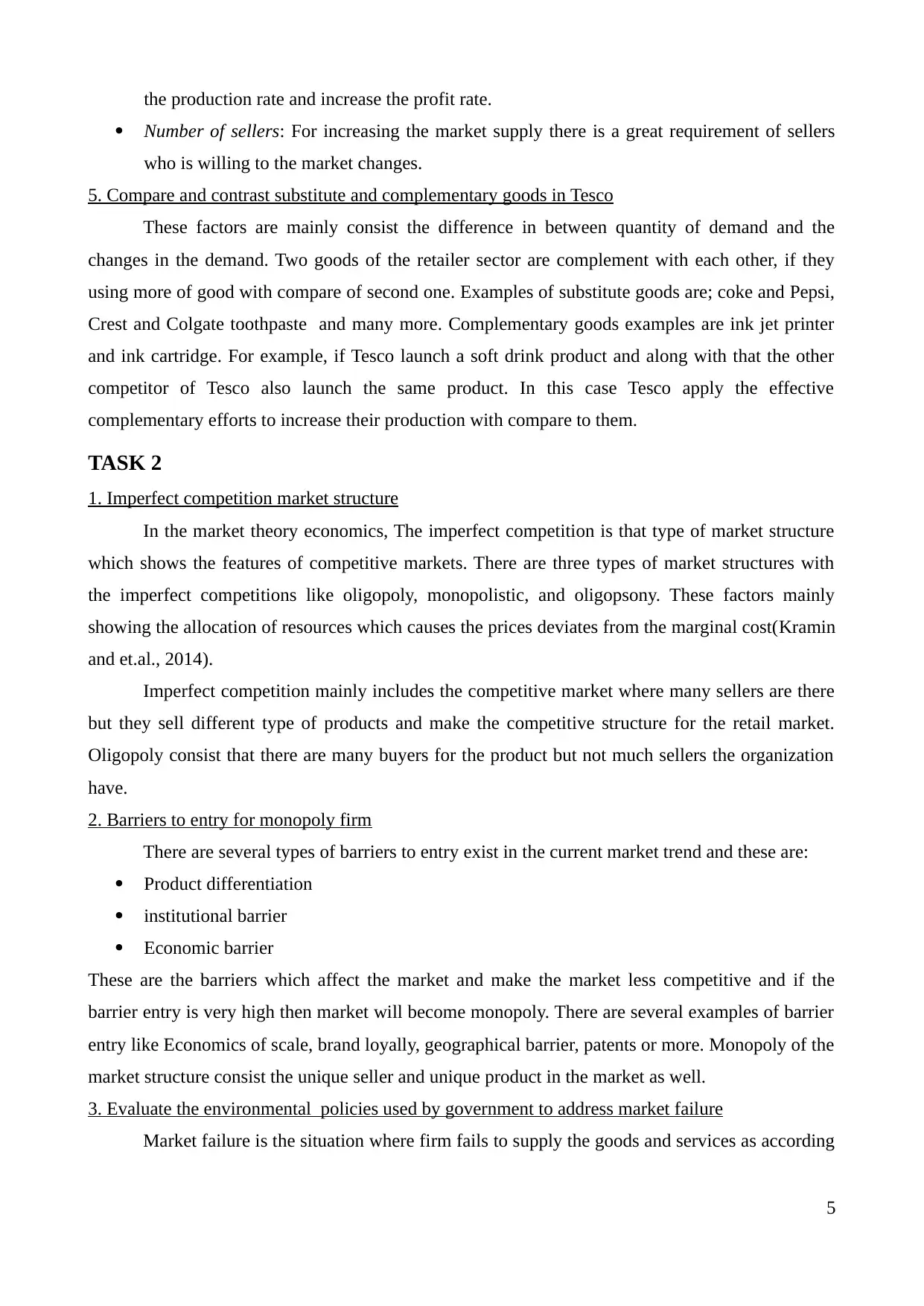
the production rate and increase the profit rate.
Number of sellers: For increasing the market supply there is a great requirement of sellers
who is willing to the market changes.
5. Compare and contrast substitute and complementary goods in Tesco
These factors are mainly consist the difference in between quantity of demand and the
changes in the demand. Two goods of the retailer sector are complement with each other, if they
using more of good with compare of second one. Examples of substitute goods are; coke and Pepsi,
Crest and Colgate toothpaste and many more. Complementary goods examples are ink jet printer
and ink cartridge. For example, if Tesco launch a soft drink product and along with that the other
competitor of Tesco also launch the same product. In this case Tesco apply the effective
complementary efforts to increase their production with compare to them.
TASK 2
1. Imperfect competition market structure
In the market theory economics, The imperfect competition is that type of market structure
which shows the features of competitive markets. There are three types of market structures with
the imperfect competitions like oligopoly, monopolistic, and oligopsony. These factors mainly
showing the allocation of resources which causes the prices deviates from the marginal cost(Kramin
and et.al., 2014).
Imperfect competition mainly includes the competitive market where many sellers are there
but they sell different type of products and make the competitive structure for the retail market.
Oligopoly consist that there are many buyers for the product but not much sellers the organization
have.
2. Barriers to entry for monopoly firm
There are several types of barriers to entry exist in the current market trend and these are:
Product differentiation
institutional barrier
Economic barrier
These are the barriers which affect the market and make the market less competitive and if the
barrier entry is very high then market will become monopoly. There are several examples of barrier
entry like Economics of scale, brand loyally, geographical barrier, patents or more. Monopoly of the
market structure consist the unique seller and unique product in the market as well.
3. Evaluate the environmental policies used by government to address market failure
Market failure is the situation where firm fails to supply the goods and services as according
5
Number of sellers: For increasing the market supply there is a great requirement of sellers
who is willing to the market changes.
5. Compare and contrast substitute and complementary goods in Tesco
These factors are mainly consist the difference in between quantity of demand and the
changes in the demand. Two goods of the retailer sector are complement with each other, if they
using more of good with compare of second one. Examples of substitute goods are; coke and Pepsi,
Crest and Colgate toothpaste and many more. Complementary goods examples are ink jet printer
and ink cartridge. For example, if Tesco launch a soft drink product and along with that the other
competitor of Tesco also launch the same product. In this case Tesco apply the effective
complementary efforts to increase their production with compare to them.
TASK 2
1. Imperfect competition market structure
In the market theory economics, The imperfect competition is that type of market structure
which shows the features of competitive markets. There are three types of market structures with
the imperfect competitions like oligopoly, monopolistic, and oligopsony. These factors mainly
showing the allocation of resources which causes the prices deviates from the marginal cost(Kramin
and et.al., 2014).
Imperfect competition mainly includes the competitive market where many sellers are there
but they sell different type of products and make the competitive structure for the retail market.
Oligopoly consist that there are many buyers for the product but not much sellers the organization
have.
2. Barriers to entry for monopoly firm
There are several types of barriers to entry exist in the current market trend and these are:
Product differentiation
institutional barrier
Economic barrier
These are the barriers which affect the market and make the market less competitive and if the
barrier entry is very high then market will become monopoly. There are several examples of barrier
entry like Economics of scale, brand loyally, geographical barrier, patents or more. Monopoly of the
market structure consist the unique seller and unique product in the market as well.
3. Evaluate the environmental policies used by government to address market failure
Market failure is the situation where firm fails to supply the goods and services as according
5
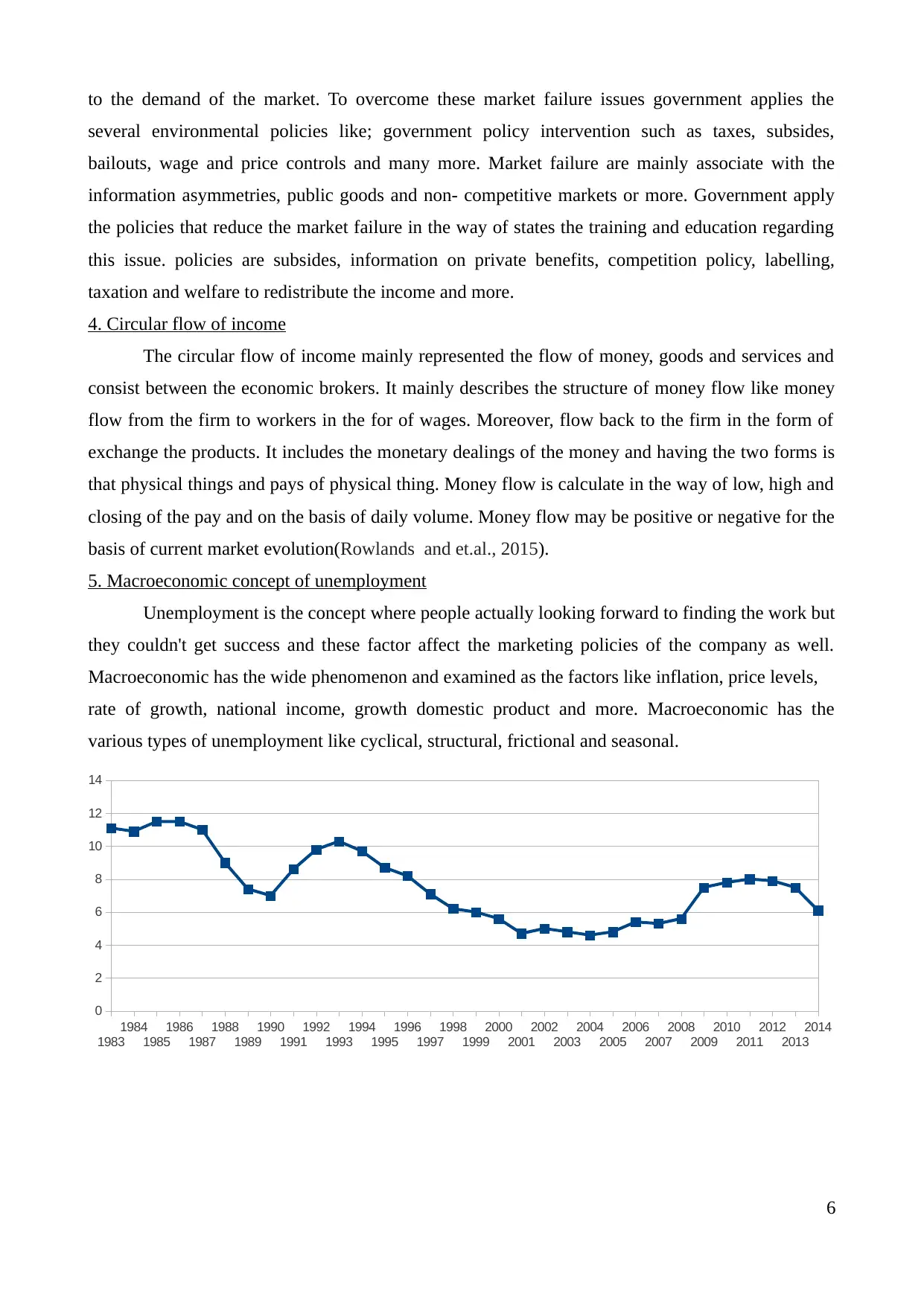
to the demand of the market. To overcome these market failure issues government applies the
several environmental policies like; government policy intervention such as taxes, subsides,
bailouts, wage and price controls and many more. Market failure are mainly associate with the
information asymmetries, public goods and non- competitive markets or more. Government apply
the policies that reduce the market failure in the way of states the training and education regarding
this issue. policies are subsides, information on private benefits, competition policy, labelling,
taxation and welfare to redistribute the income and more.
4. Circular flow of income
The circular flow of income mainly represented the flow of money, goods and services and
consist between the economic brokers. It mainly describes the structure of money flow like money
flow from the firm to workers in the for of wages. Moreover, flow back to the firm in the form of
exchange the products. It includes the monetary dealings of the money and having the two forms is
that physical things and pays of physical thing. Money flow is calculate in the way of low, high and
closing of the pay and on the basis of daily volume. Money flow may be positive or negative for the
basis of current market evolution(Rowlands and et.al., 2015).
5. Macroeconomic concept of unemployment
Unemployment is the concept where people actually looking forward to finding the work but
they couldn't get success and these factor affect the marketing policies of the company as well.
Macroeconomic has the wide phenomenon and examined as the factors like inflation, price levels,
rate of growth, national income, growth domestic product and more. Macroeconomic has the
various types of unemployment like cyclical, structural, frictional and seasonal.
6
1983
1984
1985
1986
1987
1988
1989
1990
1991
1992
1993
1994
1995
1996
1997
1998
1999
2000
2001
2002
2003
2004
2005
2006
2007
2008
2009
2010
2011
2012
2013
2014
0
2
4
6
8
10
12
14
several environmental policies like; government policy intervention such as taxes, subsides,
bailouts, wage and price controls and many more. Market failure are mainly associate with the
information asymmetries, public goods and non- competitive markets or more. Government apply
the policies that reduce the market failure in the way of states the training and education regarding
this issue. policies are subsides, information on private benefits, competition policy, labelling,
taxation and welfare to redistribute the income and more.
4. Circular flow of income
The circular flow of income mainly represented the flow of money, goods and services and
consist between the economic brokers. It mainly describes the structure of money flow like money
flow from the firm to workers in the for of wages. Moreover, flow back to the firm in the form of
exchange the products. It includes the monetary dealings of the money and having the two forms is
that physical things and pays of physical thing. Money flow is calculate in the way of low, high and
closing of the pay and on the basis of daily volume. Money flow may be positive or negative for the
basis of current market evolution(Rowlands and et.al., 2015).
5. Macroeconomic concept of unemployment
Unemployment is the concept where people actually looking forward to finding the work but
they couldn't get success and these factor affect the marketing policies of the company as well.
Macroeconomic has the wide phenomenon and examined as the factors like inflation, price levels,
rate of growth, national income, growth domestic product and more. Macroeconomic has the
various types of unemployment like cyclical, structural, frictional and seasonal.
6
1983
1984
1985
1986
1987
1988
1989
1990
1991
1992
1993
1994
1995
1996
1997
1998
1999
2000
2001
2002
2003
2004
2005
2006
2007
2008
2009
2010
2011
2012
2013
2014
0
2
4
6
8
10
12
14
⊘ This is a preview!⊘
Do you want full access?
Subscribe today to unlock all pages.

Trusted by 1+ million students worldwide
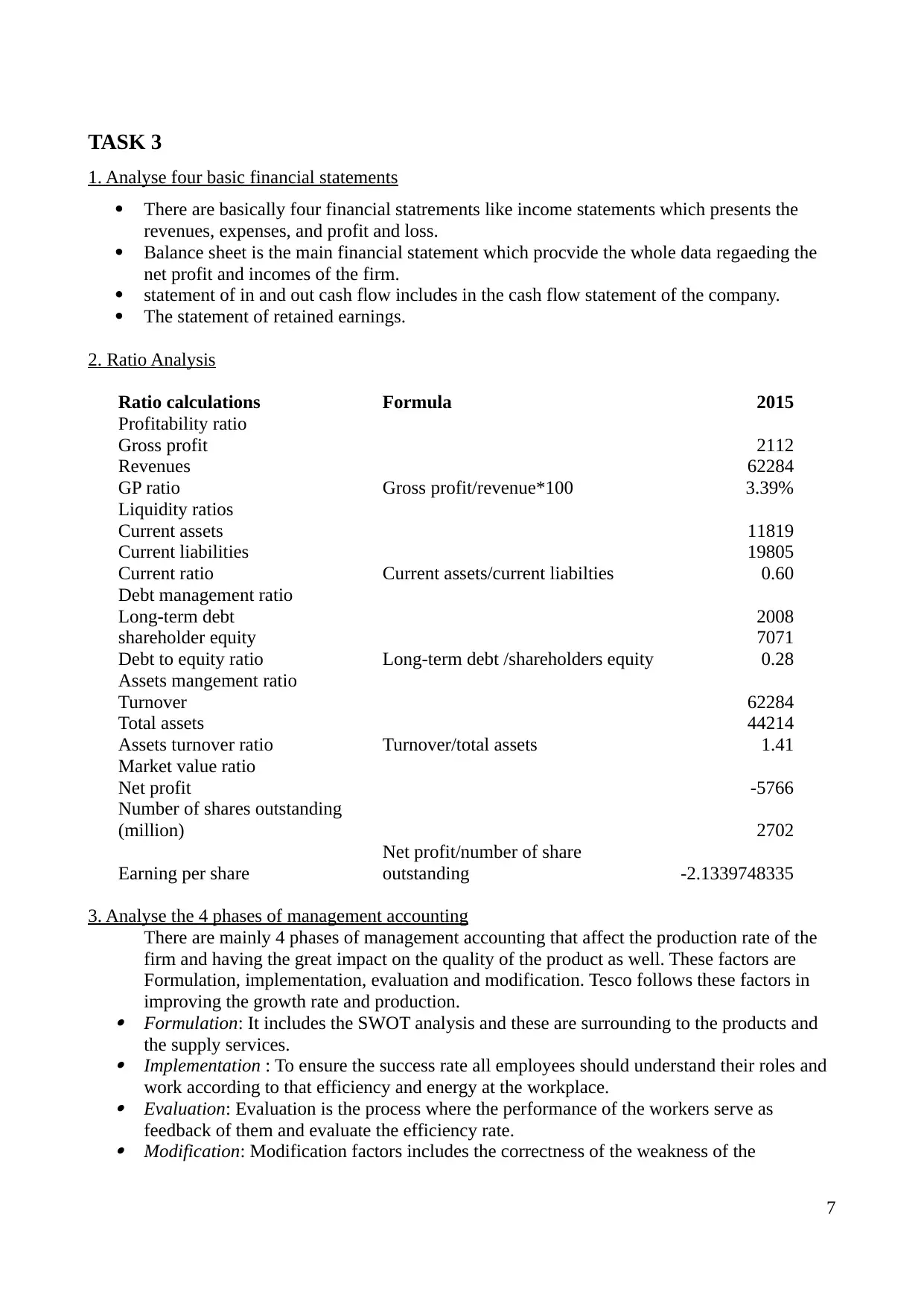
TASK 3
1. Analyse four basic financial statements
There are basically four financial statrements like income statements which presents the
revenues, expenses, and profit and loss.
Balance sheet is the main financial statement which procvide the whole data regaeding the
net profit and incomes of the firm.
statement of in and out cash flow includes in the cash flow statement of the company.
The statement of retained earnings.
2. Ratio Analysis
Ratio calculations Formula 2015
Profitability ratio
Gross profit 2112
Revenues 62284
GP ratio Gross profit/revenue*100 3.39%
Liquidity ratios
Current assets 11819
Current liabilities 19805
Current ratio Current assets/current liabilties 0.60
Debt management ratio
Long-term debt 2008
shareholder equity 7071
Debt to equity ratio Long-term debt /shareholders equity 0.28
Assets mangement ratio
Turnover 62284
Total assets 44214
Assets turnover ratio Turnover/total assets 1.41
Market value ratio
Net profit -5766
Number of shares outstanding
(million) 2702
Earning per share
Net profit/number of share
outstanding -2.1339748335
3. Analyse the 4 phases of management accounting
There are mainly 4 phases of management accounting that affect the production rate of the
firm and having the great impact on the quality of the product as well. These factors are
Formulation, implementation, evaluation and modification. Tesco follows these factors in
improving the growth rate and production.
Formulation: It includes the SWOT analysis and these are surrounding to the products and
the supply services.
Implementation : To ensure the success rate all employees should understand their roles and
work according to that efficiency and energy at the workplace.
Evaluation: Evaluation is the process where the performance of the workers serve as
feedback of them and evaluate the efficiency rate.
Modification: Modification factors includes the correctness of the weakness of the
7
1. Analyse four basic financial statements
There are basically four financial statrements like income statements which presents the
revenues, expenses, and profit and loss.
Balance sheet is the main financial statement which procvide the whole data regaeding the
net profit and incomes of the firm.
statement of in and out cash flow includes in the cash flow statement of the company.
The statement of retained earnings.
2. Ratio Analysis
Ratio calculations Formula 2015
Profitability ratio
Gross profit 2112
Revenues 62284
GP ratio Gross profit/revenue*100 3.39%
Liquidity ratios
Current assets 11819
Current liabilities 19805
Current ratio Current assets/current liabilties 0.60
Debt management ratio
Long-term debt 2008
shareholder equity 7071
Debt to equity ratio Long-term debt /shareholders equity 0.28
Assets mangement ratio
Turnover 62284
Total assets 44214
Assets turnover ratio Turnover/total assets 1.41
Market value ratio
Net profit -5766
Number of shares outstanding
(million) 2702
Earning per share
Net profit/number of share
outstanding -2.1339748335
3. Analyse the 4 phases of management accounting
There are mainly 4 phases of management accounting that affect the production rate of the
firm and having the great impact on the quality of the product as well. These factors are
Formulation, implementation, evaluation and modification. Tesco follows these factors in
improving the growth rate and production.
Formulation: It includes the SWOT analysis and these are surrounding to the products and
the supply services.
Implementation : To ensure the success rate all employees should understand their roles and
work according to that efficiency and energy at the workplace.
Evaluation: Evaluation is the process where the performance of the workers serve as
feedback of them and evaluate the efficiency rate.
Modification: Modification factors includes the correctness of the weakness of the
7
Paraphrase This Document
Need a fresh take? Get an instant paraphrase of this document with our AI Paraphraser
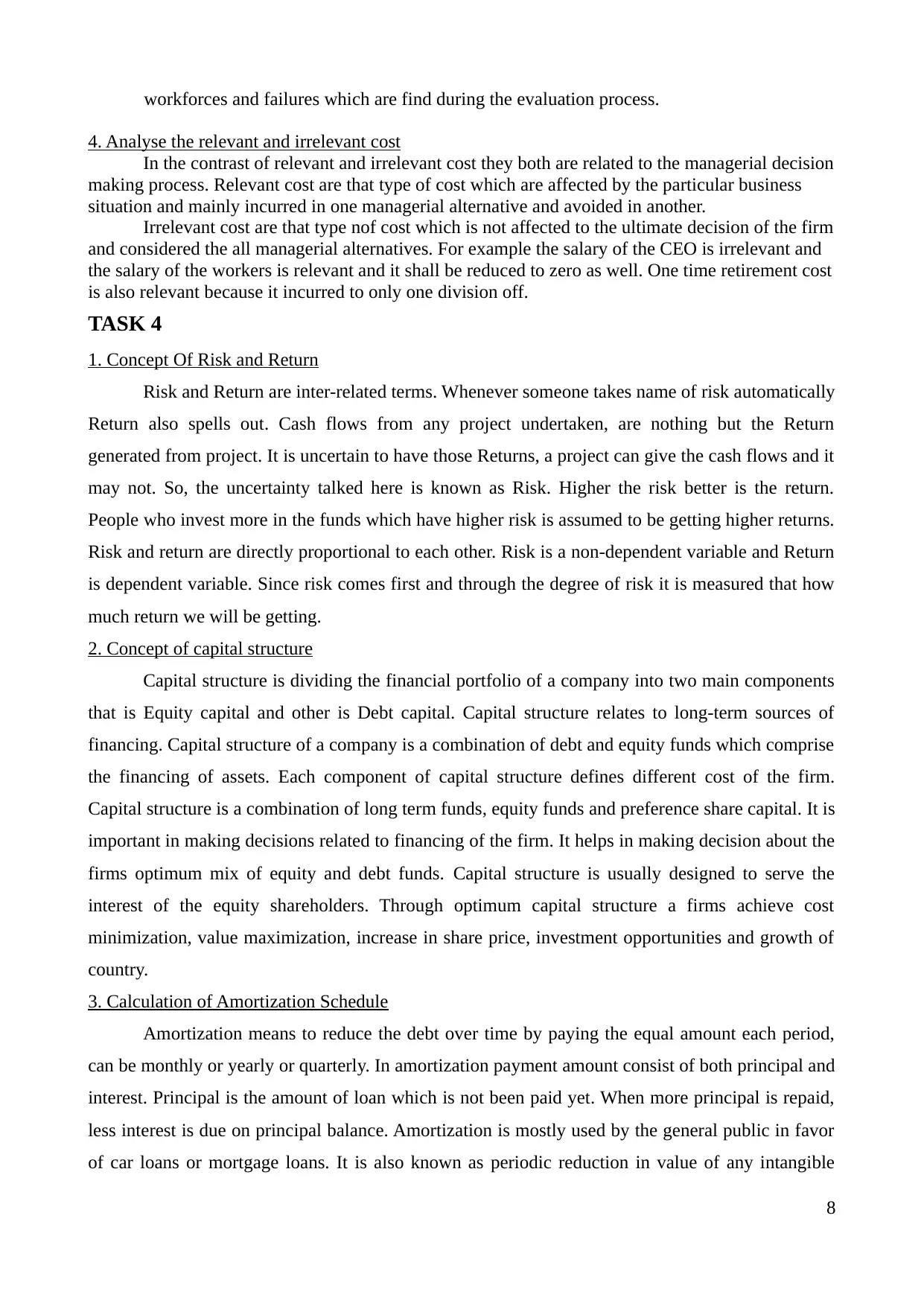
workforces and failures which are find during the evaluation process.
4. Analyse the relevant and irrelevant cost
In the contrast of relevant and irrelevant cost they both are related to the managerial decision
making process. Relevant cost are that type of cost which are affected by the particular business
situation and mainly incurred in one managerial alternative and avoided in another.
Irrelevant cost are that type nof cost which is not affected to the ultimate decision of the firm
and considered the all managerial alternatives. For example the salary of the CEO is irrelevant and
the salary of the workers is relevant and it shall be reduced to zero as well. One time retirement cost
is also relevant because it incurred to only one division off.
TASK 4
1. Concept Of Risk and Return
Risk and Return are inter-related terms. Whenever someone takes name of risk automatically
Return also spells out. Cash flows from any project undertaken, are nothing but the Return
generated from project. It is uncertain to have those Returns, a project can give the cash flows and it
may not. So, the uncertainty talked here is known as Risk. Higher the risk better is the return.
People who invest more in the funds which have higher risk is assumed to be getting higher returns.
Risk and return are directly proportional to each other. Risk is a non-dependent variable and Return
is dependent variable. Since risk comes first and through the degree of risk it is measured that how
much return we will be getting.
2. Concept of capital structure
Capital structure is dividing the financial portfolio of a company into two main components
that is Equity capital and other is Debt capital. Capital structure relates to long-term sources of
financing. Capital structure of a company is a combination of debt and equity funds which comprise
the financing of assets. Each component of capital structure defines different cost of the firm.
Capital structure is a combination of long term funds, equity funds and preference share capital. It is
important in making decisions related to financing of the firm. It helps in making decision about the
firms optimum mix of equity and debt funds. Capital structure is usually designed to serve the
interest of the equity shareholders. Through optimum capital structure a firms achieve cost
minimization, value maximization, increase in share price, investment opportunities and growth of
country.
3. Calculation of Amortization Schedule
Amortization means to reduce the debt over time by paying the equal amount each period,
can be monthly or yearly or quarterly. In amortization payment amount consist of both principal and
interest. Principal is the amount of loan which is not been paid yet. When more principal is repaid,
less interest is due on principal balance. Amortization is mostly used by the general public in favor
of car loans or mortgage loans. It is also known as periodic reduction in value of any intangible
8
4. Analyse the relevant and irrelevant cost
In the contrast of relevant and irrelevant cost they both are related to the managerial decision
making process. Relevant cost are that type of cost which are affected by the particular business
situation and mainly incurred in one managerial alternative and avoided in another.
Irrelevant cost are that type nof cost which is not affected to the ultimate decision of the firm
and considered the all managerial alternatives. For example the salary of the CEO is irrelevant and
the salary of the workers is relevant and it shall be reduced to zero as well. One time retirement cost
is also relevant because it incurred to only one division off.
TASK 4
1. Concept Of Risk and Return
Risk and Return are inter-related terms. Whenever someone takes name of risk automatically
Return also spells out. Cash flows from any project undertaken, are nothing but the Return
generated from project. It is uncertain to have those Returns, a project can give the cash flows and it
may not. So, the uncertainty talked here is known as Risk. Higher the risk better is the return.
People who invest more in the funds which have higher risk is assumed to be getting higher returns.
Risk and return are directly proportional to each other. Risk is a non-dependent variable and Return
is dependent variable. Since risk comes first and through the degree of risk it is measured that how
much return we will be getting.
2. Concept of capital structure
Capital structure is dividing the financial portfolio of a company into two main components
that is Equity capital and other is Debt capital. Capital structure relates to long-term sources of
financing. Capital structure of a company is a combination of debt and equity funds which comprise
the financing of assets. Each component of capital structure defines different cost of the firm.
Capital structure is a combination of long term funds, equity funds and preference share capital. It is
important in making decisions related to financing of the firm. It helps in making decision about the
firms optimum mix of equity and debt funds. Capital structure is usually designed to serve the
interest of the equity shareholders. Through optimum capital structure a firms achieve cost
minimization, value maximization, increase in share price, investment opportunities and growth of
country.
3. Calculation of Amortization Schedule
Amortization means to reduce the debt over time by paying the equal amount each period,
can be monthly or yearly or quarterly. In amortization payment amount consist of both principal and
interest. Principal is the amount of loan which is not been paid yet. When more principal is repaid,
less interest is due on principal balance. Amortization is mostly used by the general public in favor
of car loans or mortgage loans. It is also known as periodic reduction in value of any intangible
8
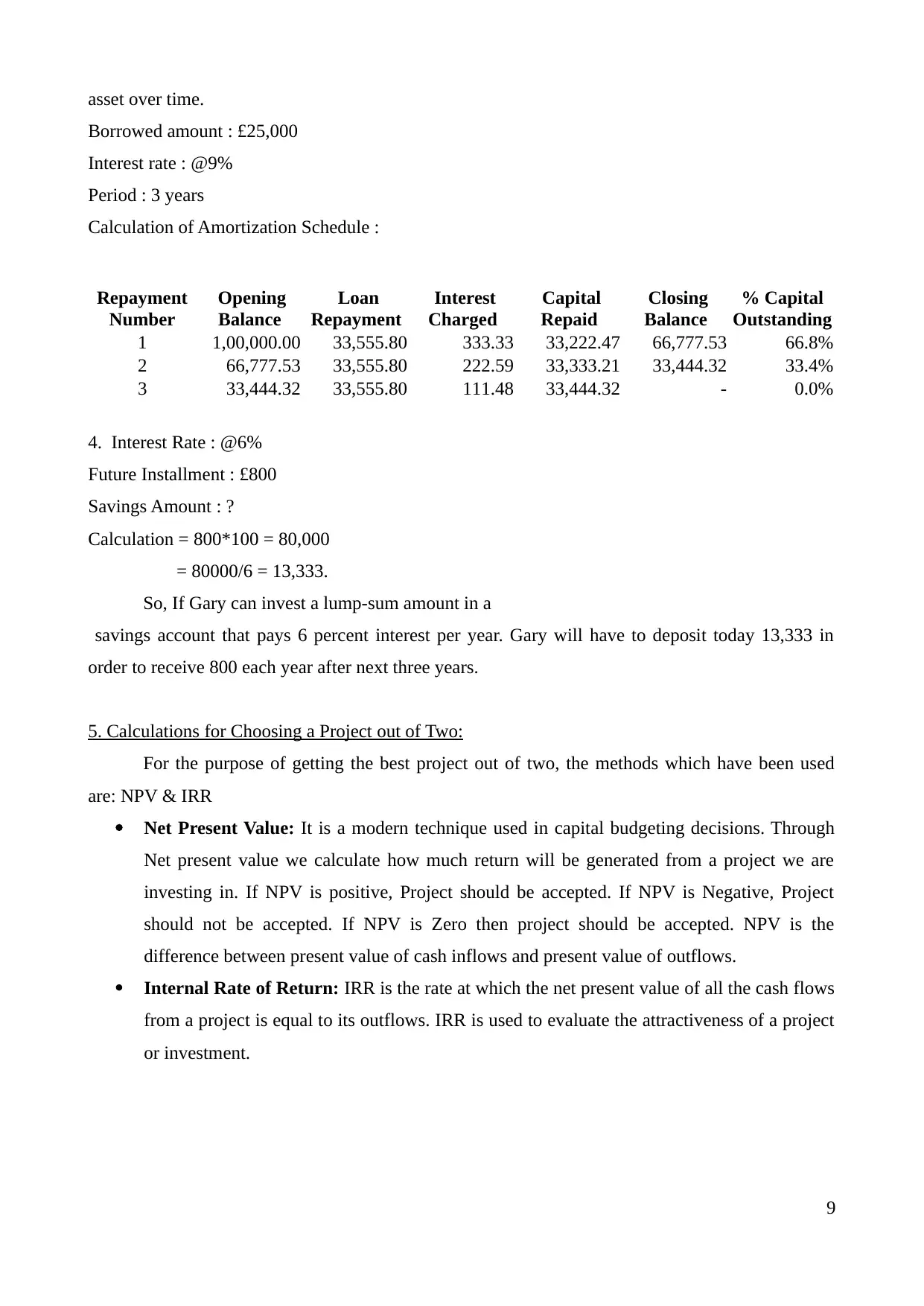
asset over time.
Borrowed amount : £25,000
Interest rate : @9%
Period : 3 years
Calculation of Amortization Schedule :
Repayment
Number
Opening
Balance
Loan
Repayment
Interest
Charged
Capital
Repaid
Closing
Balance
% Capital
Outstanding
1 1,00,000.00 33,555.80 333.33 33,222.47 66,777.53 66.8%
2 66,777.53 33,555.80 222.59 33,333.21 33,444.32 33.4%
3 33,444.32 33,555.80 111.48 33,444.32 - 0.0%
4. Interest Rate : @6%
Future Installment : £800
Savings Amount : ?
Calculation = 800*100 = 80,000
= 80000/6 = 13,333.
So, If Gary can invest a lump-sum amount in a
savings account that pays 6 percent interest per year. Gary will have to deposit today 13,333 in
order to receive 800 each year after next three years.
5. Calculations for Choosing a Project out of Two:
For the purpose of getting the best project out of two, the methods which have been used
are: NPV & IRR
Net Present Value: It is a modern technique used in capital budgeting decisions. Through
Net present value we calculate how much return will be generated from a project we are
investing in. If NPV is positive, Project should be accepted. If NPV is Negative, Project
should not be accepted. If NPV is Zero then project should be accepted. NPV is the
difference between present value of cash inflows and present value of outflows.
Internal Rate of Return: IRR is the rate at which the net present value of all the cash flows
from a project is equal to its outflows. IRR is used to evaluate the attractiveness of a project
or investment.
9
Borrowed amount : £25,000
Interest rate : @9%
Period : 3 years
Calculation of Amortization Schedule :
Repayment
Number
Opening
Balance
Loan
Repayment
Interest
Charged
Capital
Repaid
Closing
Balance
% Capital
Outstanding
1 1,00,000.00 33,555.80 333.33 33,222.47 66,777.53 66.8%
2 66,777.53 33,555.80 222.59 33,333.21 33,444.32 33.4%
3 33,444.32 33,555.80 111.48 33,444.32 - 0.0%
4. Interest Rate : @6%
Future Installment : £800
Savings Amount : ?
Calculation = 800*100 = 80,000
= 80000/6 = 13,333.
So, If Gary can invest a lump-sum amount in a
savings account that pays 6 percent interest per year. Gary will have to deposit today 13,333 in
order to receive 800 each year after next three years.
5. Calculations for Choosing a Project out of Two:
For the purpose of getting the best project out of two, the methods which have been used
are: NPV & IRR
Net Present Value: It is a modern technique used in capital budgeting decisions. Through
Net present value we calculate how much return will be generated from a project we are
investing in. If NPV is positive, Project should be accepted. If NPV is Negative, Project
should not be accepted. If NPV is Zero then project should be accepted. NPV is the
difference between present value of cash inflows and present value of outflows.
Internal Rate of Return: IRR is the rate at which the net present value of all the cash flows
from a project is equal to its outflows. IRR is used to evaluate the attractiveness of a project
or investment.
9
⊘ This is a preview!⊘
Do you want full access?
Subscribe today to unlock all pages.

Trusted by 1+ million students worldwide
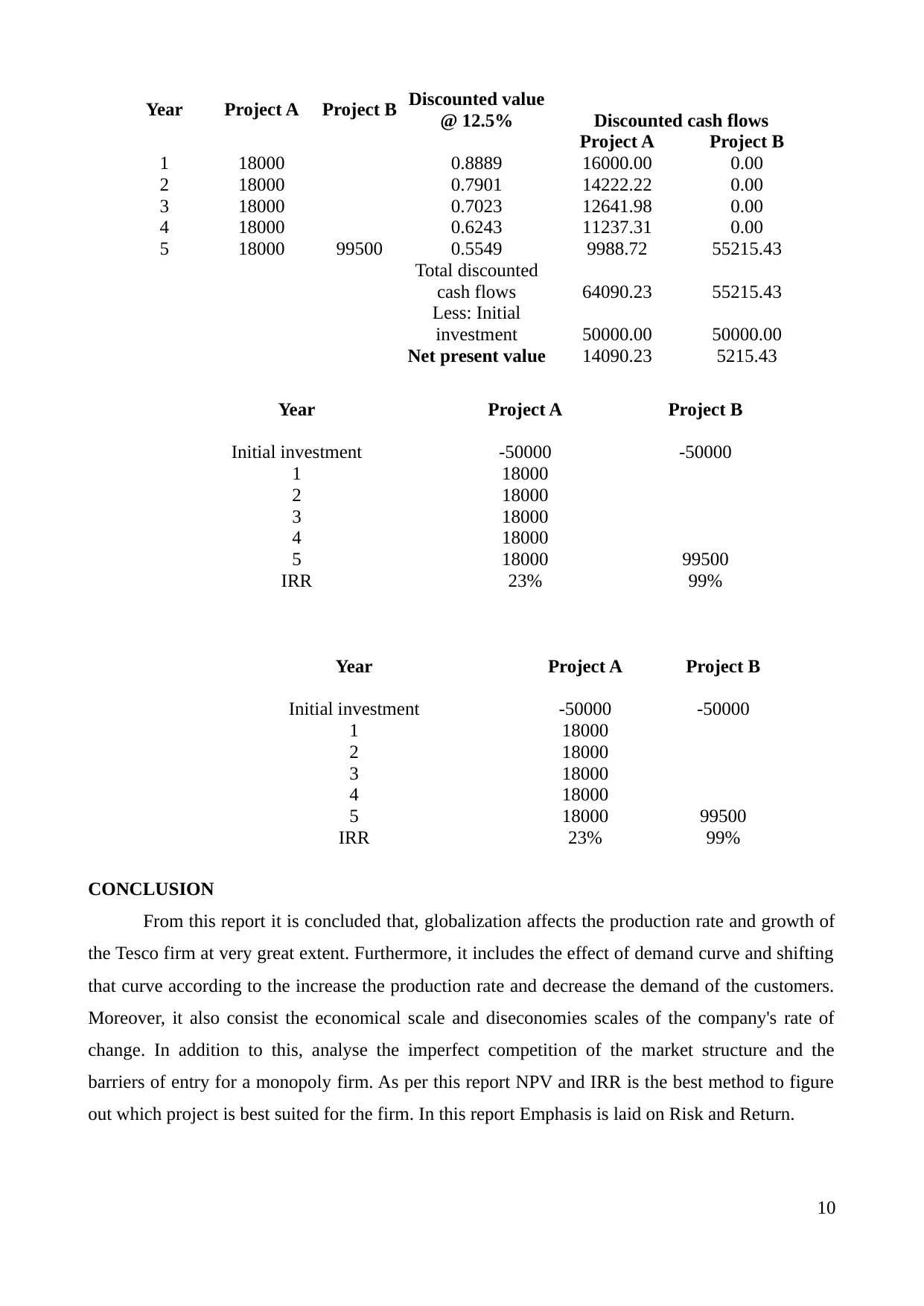
Year Project A Project B Discounted value
@ 12.5% Discounted cash flows
Project A Project B
1 18000 0.8889 16000.00 0.00
2 18000 0.7901 14222.22 0.00
3 18000 0.7023 12641.98 0.00
4 18000 0.6243 11237.31 0.00
5 18000 99500 0.5549 9988.72 55215.43
Total discounted
cash flows 64090.23 55215.43
Less: Initial
investment 50000.00 50000.00
Net present value 14090.23 5215.43
Year Project A Project B
Initial investment -50000 -50000
1 18000
2 18000
3 18000
4 18000
5 18000 99500
IRR 23% 99%
Year Project A Project B
Initial investment -50000 -50000
1 18000
2 18000
3 18000
4 18000
5 18000 99500
IRR 23% 99%
CONCLUSION
From this report it is concluded that, globalization affects the production rate and growth of
the Tesco firm at very great extent. Furthermore, it includes the effect of demand curve and shifting
that curve according to the increase the production rate and decrease the demand of the customers.
Moreover, it also consist the economical scale and diseconomies scales of the company's rate of
change. In addition to this, analyse the imperfect competition of the market structure and the
barriers of entry for a monopoly firm. As per this report NPV and IRR is the best method to figure
out which project is best suited for the firm. In this report Emphasis is laid on Risk and Return.
10
@ 12.5% Discounted cash flows
Project A Project B
1 18000 0.8889 16000.00 0.00
2 18000 0.7901 14222.22 0.00
3 18000 0.7023 12641.98 0.00
4 18000 0.6243 11237.31 0.00
5 18000 99500 0.5549 9988.72 55215.43
Total discounted
cash flows 64090.23 55215.43
Less: Initial
investment 50000.00 50000.00
Net present value 14090.23 5215.43
Year Project A Project B
Initial investment -50000 -50000
1 18000
2 18000
3 18000
4 18000
5 18000 99500
IRR 23% 99%
Year Project A Project B
Initial investment -50000 -50000
1 18000
2 18000
3 18000
4 18000
5 18000 99500
IRR 23% 99%
CONCLUSION
From this report it is concluded that, globalization affects the production rate and growth of
the Tesco firm at very great extent. Furthermore, it includes the effect of demand curve and shifting
that curve according to the increase the production rate and decrease the demand of the customers.
Moreover, it also consist the economical scale and diseconomies scales of the company's rate of
change. In addition to this, analyse the imperfect competition of the market structure and the
barriers of entry for a monopoly firm. As per this report NPV and IRR is the best method to figure
out which project is best suited for the firm. In this report Emphasis is laid on Risk and Return.
10
Paraphrase This Document
Need a fresh take? Get an instant paraphrase of this document with our AI Paraphraser
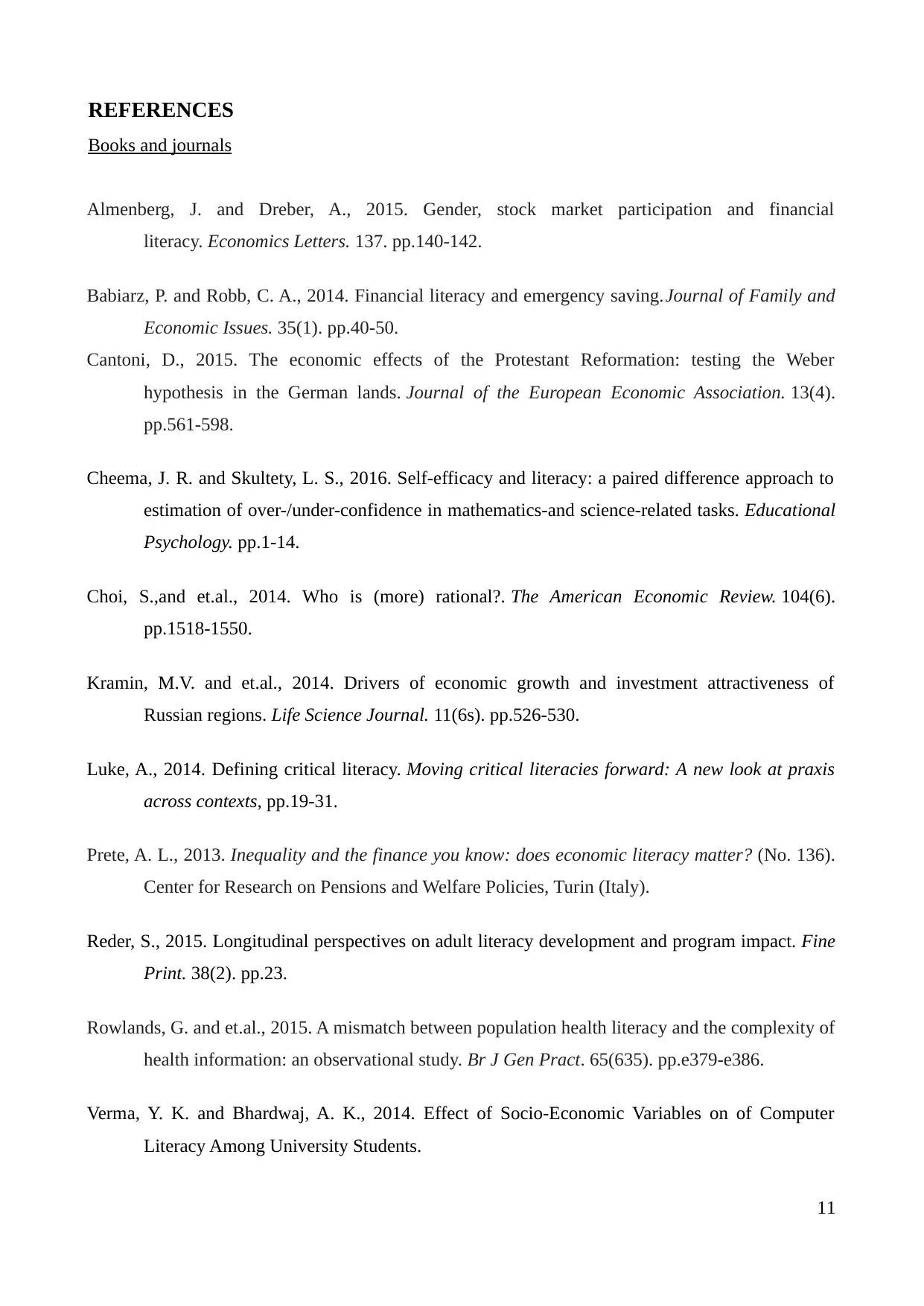
REFERENCES
Books and journals
Almenberg, J. and Dreber, A., 2015. Gender, stock market participation and financial
literacy. Economics Letters. 137. pp.140-142.
Babiarz, P. and Robb, C. A., 2014. Financial literacy and emergency saving.Journal of Family and
Economic Issues. 35(1). pp.40-50.
Cantoni, D., 2015. The economic effects of the Protestant Reformation: testing the Weber
hypothesis in the German lands. Journal of the European Economic Association. 13(4).
pp.561-598.
Cheema, J. R. and Skultety, L. S., 2016. Self-efficacy and literacy: a paired difference approach to
estimation of over-/under-confidence in mathematics-and science-related tasks. Educational
Psychology. pp.1-14.
Choi, S.,and et.al., 2014. Who is (more) rational?. The American Economic Review. 104(6).
pp.1518-1550.
Kramin, M.V. and et.al., 2014. Drivers of economic growth and investment attractiveness of
Russian regions. Life Science Journal. 11(6s). pp.526-530.
Luke, A., 2014. Defining critical literacy. Moving critical literacies forward: A new look at praxis
across contexts, pp.19-31.
Prete, A. L., 2013. Inequality and the finance you know: does economic literacy matter? (No. 136).
Center for Research on Pensions and Welfare Policies, Turin (Italy).
Reder, S., 2015. Longitudinal perspectives on adult literacy development and program impact. Fine
Print. 38(2). pp.23.
Rowlands, G. and et.al., 2015. A mismatch between population health literacy and the complexity of
health information: an observational study. Br J Gen Pract. 65(635). pp.e379-e386.
Verma, Y. K. and Bhardwaj, A. K., 2014. Effect of Socio-Economic Variables on of Computer
Literacy Among University Students.
11
Books and journals
Almenberg, J. and Dreber, A., 2015. Gender, stock market participation and financial
literacy. Economics Letters. 137. pp.140-142.
Babiarz, P. and Robb, C. A., 2014. Financial literacy and emergency saving.Journal of Family and
Economic Issues. 35(1). pp.40-50.
Cantoni, D., 2015. The economic effects of the Protestant Reformation: testing the Weber
hypothesis in the German lands. Journal of the European Economic Association. 13(4).
pp.561-598.
Cheema, J. R. and Skultety, L. S., 2016. Self-efficacy and literacy: a paired difference approach to
estimation of over-/under-confidence in mathematics-and science-related tasks. Educational
Psychology. pp.1-14.
Choi, S.,and et.al., 2014. Who is (more) rational?. The American Economic Review. 104(6).
pp.1518-1550.
Kramin, M.V. and et.al., 2014. Drivers of economic growth and investment attractiveness of
Russian regions. Life Science Journal. 11(6s). pp.526-530.
Luke, A., 2014. Defining critical literacy. Moving critical literacies forward: A new look at praxis
across contexts, pp.19-31.
Prete, A. L., 2013. Inequality and the finance you know: does economic literacy matter? (No. 136).
Center for Research on Pensions and Welfare Policies, Turin (Italy).
Reder, S., 2015. Longitudinal perspectives on adult literacy development and program impact. Fine
Print. 38(2). pp.23.
Rowlands, G. and et.al., 2015. A mismatch between population health literacy and the complexity of
health information: an observational study. Br J Gen Pract. 65(635). pp.e379-e386.
Verma, Y. K. and Bhardwaj, A. K., 2014. Effect of Socio-Economic Variables on of Computer
Literacy Among University Students.
11
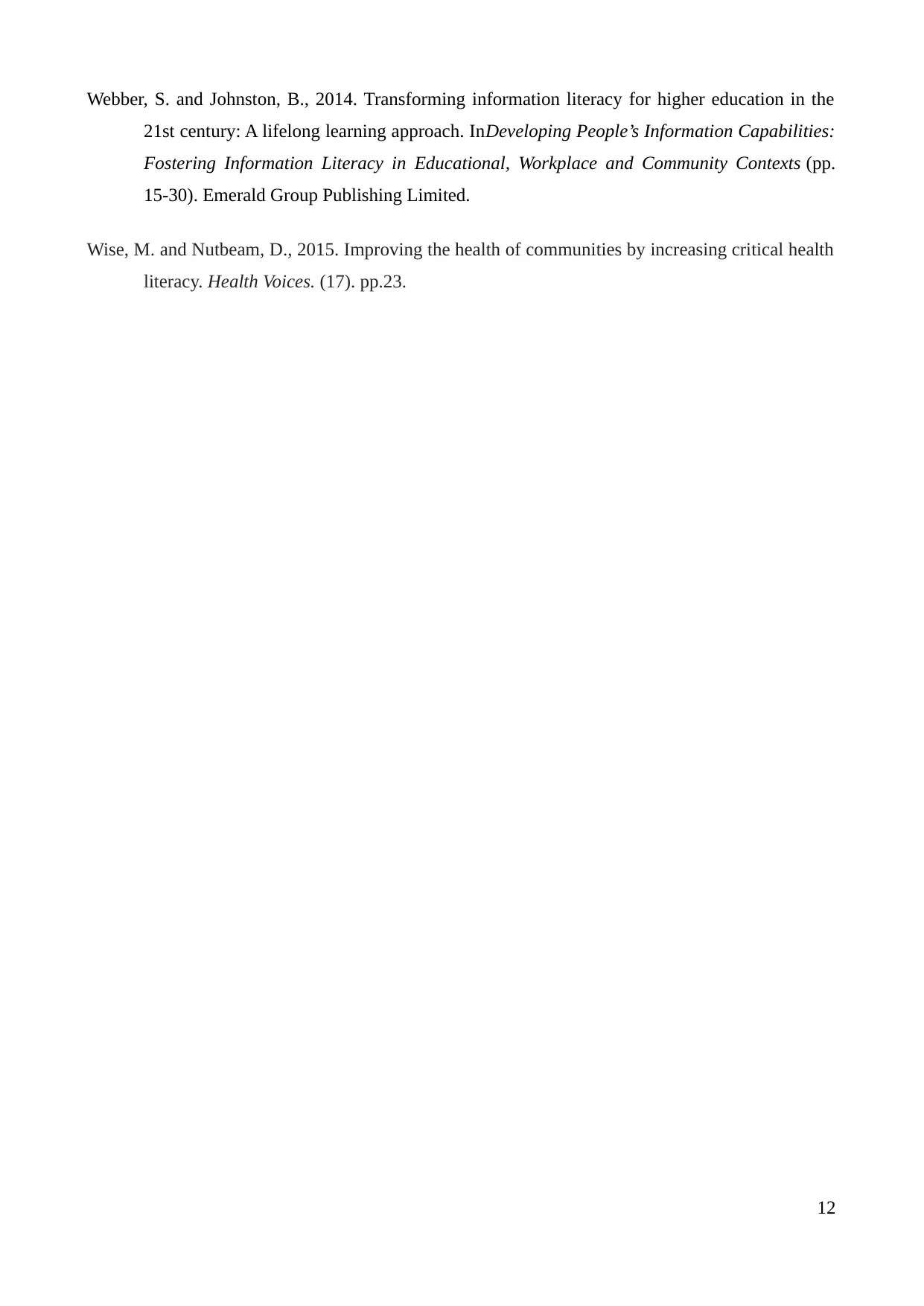
Webber, S. and Johnston, B., 2014. Transforming information literacy for higher education in the
21st century: A lifelong learning approach. InDeveloping People’s Information Capabilities:
Fostering Information Literacy in Educational, Workplace and Community Contexts (pp.
15-30). Emerald Group Publishing Limited.
Wise, M. and Nutbeam, D., 2015. Improving the health of communities by increasing critical health
literacy. Health Voices. (17). pp.23.
12
21st century: A lifelong learning approach. InDeveloping People’s Information Capabilities:
Fostering Information Literacy in Educational, Workplace and Community Contexts (pp.
15-30). Emerald Group Publishing Limited.
Wise, M. and Nutbeam, D., 2015. Improving the health of communities by increasing critical health
literacy. Health Voices. (17). pp.23.
12
⊘ This is a preview!⊘
Do you want full access?
Subscribe today to unlock all pages.

Trusted by 1+ million students worldwide
1 out of 12
Related Documents
Your All-in-One AI-Powered Toolkit for Academic Success.
+13062052269
info@desklib.com
Available 24*7 on WhatsApp / Email
![[object Object]](/_next/static/media/star-bottom.7253800d.svg)
Unlock your academic potential
Copyright © 2020–2025 A2Z Services. All Rights Reserved. Developed and managed by ZUCOL.



